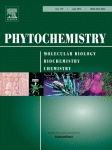Ver ítem
- xmlui.general.dspace_homeCentros Regionales y EEAsCentro Regional Mendoza - San JuanEEA La ConsultaArtículos científicosxmlui.ArtifactBrowser.ItemViewer.trail
- Inicio
- Centros Regionales y EEAs
- Centro Regional Mendoza - San Juan
- EEA La Consulta
- Artículos científicos
- Ver ítem
Allium sativum produces terpenes with fungistatic properties in response to infection with Sclerotium cepivorum
Resumen
This study investigated terpene biosynthesis in different tissues (root, protobulb, leaf sheath and blade) of in vitro -grown garlic plants either infected or not (control) with Sclerotium cepivorum, the causative agent of Allium White Rot disease. The terpenes identified by gas chromatography–electron impact mass spectrometry (GC-EIMS) in infected plants were nerolidol, phytol, squalene, a-pinene, terpinolene, limo-nene, 1,8-cineole and c-terpinene,
[ver mas...]
This study investigated terpene biosynthesis in different tissues (root, protobulb, leaf sheath and blade) of in vitro -grown garlic plants either infected or not (control) with Sclerotium cepivorum, the causative agent of Allium White Rot disease. The terpenes identified by gas chromatography–electron impact mass spectrometry (GC-EIMS) in infected plants were nerolidol, phytol, squalene, a-pinene, terpinolene, limo-nene, 1,8-cineole and c-terpinene, whose levels significantly increased when exposed to the fungus. Consistent with this, an increase in terpene synthase (TPS) activity was measured in infected plants. Among the terpenes identified, nerolidol, a-pinene and terpinolene were the most abundant with antifungal activity against S. cepivorum being assessed in vitro by mycelium growth inhibition. Nerolidol and terpinolene significantly reduced sclerotia production, while a-pinene stimulated it in a concentration-dependent manner. Parallel to fungal growth inhibition, electron microscopy observations
established morphological alterations in the hyphae exposed to terpinolene and nerolidol. Differences in hyphal EtBr uptake suggested that one of the antifungal mechanisms of nerolidol and terpinolene migh be disruption of fungal membrane integrity
[Cerrar]

Autor
Pontin, Mariela Ana;
Piccoli, Patricia Noemí;
Burba, Jose Luis;
Bottini, Ambrosio Rubén;
Fuente
Phytochemistry 115 :152-160. (July 2015)
Fecha
2015-07
ISSN
0031-9422 (Print)
1873-3700 (Online)
1873-3700 (Online)
Formato
pdf
Tipo de documento
article
Palabras Claves
Derechos de acceso
Restringido
 Excepto donde se diga explicitamente, este item se publica bajo la siguiente descripción: Creative Commons Attribution-NonCommercial-ShareAlike 2.5 Unported (CC BY-NC-SA 2.5)
Excepto donde se diga explicitamente, este item se publica bajo la siguiente descripción: Creative Commons Attribution-NonCommercial-ShareAlike 2.5 Unported (CC BY-NC-SA 2.5)

